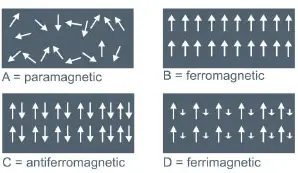The magnetic materials are classified into 5 types
- Diamagnetic Material
- Paramagnetic Material
- Ferromagnetic Material
- Anti-ferromagnetic Material
- Ferri Magnetic Material

1. Diamagnetic Material
- These material have smaller and negative magnetic susceptibility.
- These material are repelled by applied magnetic field.
- The magnetic flux density inside diamagnetic material is zero.
B = 0
µo[ H + M ] = 0
M = − H
Therefore, M = χm H
χm = − 1
⇒ µr − 1 = − 1
µr = 0
The above relation µr = 0, all the perfect diamagnetism is one of the necessary conditions for a material to be a superconductor. The magnetic susceptibility of these materials is independent of temperature. Example: Si, Ge, diamond, NaCl, Al2O3, Cu, gold, etc.
2. Paramagnetic Material
When this material is placed in an external electrical field, acquires a weak magnetism in the same direction of magnetic field. Examples: FeSO4, MnSO4, NiSO4, Fe2O3, etc.
- This material has a small positive value of magnetic susceptibility. In paramagnetic material, the permanent dipole moment of the atoms and ions has no mutual interaction. However, in the presence of a field, the magnetic moment has a tendency to turn towards the direction of applied field.
- If no opposing force act, complete alignment of the dipole will be produced and the specimen would acquire a large magnetism but thermal agitation of atoms opposes this tendency and tends to keep the dipole moment at random.
This result only a partial alignment in the field direction. Therefore, a weak magnetism and a small positive value of susceptibility. The effect of increasing the temperature is to increase the thermal agitation and therefore decrease the susceptibility.
The magnetisation is governed by a law called Curie law.
3. Ferromagnetic Material
These are the material which gets magnetise in the direction of the external magnetic field and remain magnetised even after the removal of the magnetic field. This property of the ferromagnetic material is called Spontaneous magnetisation.Examples: Fe, Co, Ni, Gd (Gadolinium), Dy (Dysprosium), etc.
- The direction of magnetisation can be reversed by reversing the direction of the external magnetic field.
- The ferromagnetic material is characterized by parallel alignment of the magnetic dipole.
4. Antiferromagnetic Material
- The dipole moment in these materials is aligned in the antiparallel direction.
- The net magnetisation is zero when no external field is applied but when the material is subjected to an external field, the dipole moment starts aligned in the direction of the field.
- These materials have small and positive values of susceptibility.
- These materials are antiferromagnetic up to zero critical temperature called as Neel temperature.
- Above Neel temperature, these materials start behaving like paramagnetic material.
- Example: MnO2, MnO, FeO, CoO, etc.
5. Ferrimagnetic material
- In Ferrimagnetic material, the dipole moment of the adjacent atom are also aligned in opposite direction but they are not equal in strength.
- These materials remain ferrimagnetic up to a critical temperature called Curie temperature. Above this temperature, this material starts behaving like paramagnetic.
- The advantage of these materials is high d.c. resistivity as compared to the ferromagnetic material.
- Because of this property, the current losses in ferrite are lesser than ferromagnetic material. Because of this reason, ferrites are preferred for the construction of the core of high frequency.
Ferrite is a type of ceramic compound composed of iron oxide and other metallic elements. They are both electrically non-conductive and ferrimagnetic.
Electrical & Magnetic Characteristics of ferrites
- High d.c. resistivity
- Low eddy current losses
- High permeability
- High dielectric constant
- High Curie temperature
Based on Applications, Ferrites can be classified as
- Hard Ferrites
- Soft ferrites
- Rectangular ferrites
- Microwave ferrites
1. Soft ferrites
- These are ferrites that are used for the construction of the core of inductors and transformers.
- These materials have high permeability, low coercive force, and low eddy current losses.
- Examples: Mn & Zn ferrites; Ni-Zn ferrites are used in audio & TV transformer.
2. Hard Ferrites
- These are ferrites that are used for the construction of the permanent magnets.
- These materials have high permeability, high coercive force, and high resistivity.
- Examples: Ba & Sr ferrites.
3. Rectangular ferrites
- These ferrites are having a rectangular shape of the hysteresis curve.
- These ferrites are used as the core of the magnetic memories.
- Examples: Mn-Mg ferrites, Ni-Li ferrites, Mn-Cu ferrites.
4. Microwave ferrites
- These ferrites are used at microwave frequency.
- At this frequency, the electromagnetic wave interacts with the spin magnetic moment of an electron because of this the plane of polarisation of electromagnetic field gets rotated by some angle when the wave passes through the material, this phenomena is called as Faraday rotation.
- These ferrites are used in microwave devices. Examples: gyrators, circulators, isolators, etc.
- Examples: Mn ferrite, Ni ferrite, Co ferrite, Garnets (VIG = Veltrium iron garnet)
- Garnets are used in magnetic bubble memory.
Ferrites from magnetite = MOFe2O3
where, M = bivalent element such as Cu, Zn, Co, Ni, etc.
Ferrites from Garnets = 3M2O3. 5Fe2O3
These are called rare earth ferrites.
